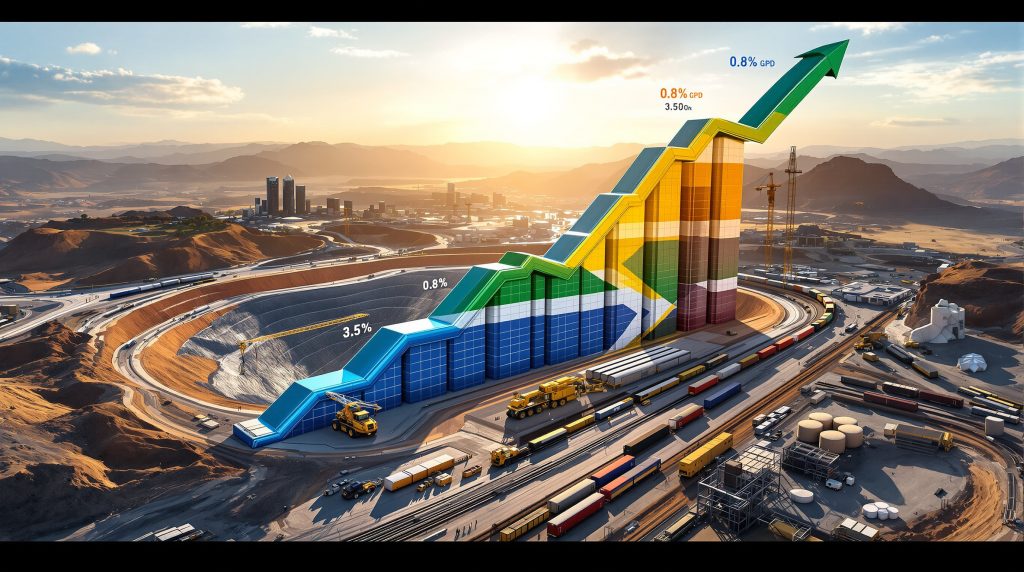How Did Mining Drive South Africa's Recent GDP Growth?
South Africa's economy showed modest improvement in the second quarter of 2025, growing by 0.8% quarter-on-quarter (seasonally adjusted). This represents a significant improvement from the anemic 0.1% growth recorded in Q1 2025. The mining sector emerged as the primary growth engine, expanding by 3.7% and contributing 0.2 percentage points to the overall GDP growth figure.
This performance marks the strongest quarterly economic expansion since Q2 2023, when the economy also grew by 0.8%. The mining industry trends helped offset weaknesses in other areas of the economy, particularly in transportation and construction.
According to Statistics South Africa's latest economic report, the mining sector's exceptional performance was largely driven by increased production volumes across several key mineral categories, establishing it as the most significant contributor to the nation's economic recovery during this period.
The Role of Commodity Prices
The mining sector's strong performance coincided with favorable global commodity price movements. Gold prices reached all-time highs above $2,400 per ounce during Q2 2025, while platinum group metals maintained stability despite global market volatility. These price dynamics created a supportive environment for mining companies to increase production and capitalize on improved profit margins.
Industry analysts note that this combination of increased production volumes and favorable pricing created an ideal scenario for the sector to drive economic growth during an otherwise challenging period for the South African economy.
Which Sectors Contributed to South Africa's Q2 2025 Growth?
Positive Contributors
The economic growth in Q2 2025 was supported by several key sectors:
| Sector | Growth Rate (q-o-q) | Contribution to GDP |
|---|---|---|
| Mining | +3.7% | 0.2 percentage points |
| Manufacturing | +1.8% | 0.2 percentage points |
| Trade | +1.7% | 0.2 percentage points |
| Agriculture | Not specified | 0.1 percentage points |
| Finance | Not specified | 0.1 percentage points |
| Government services | Not specified | 0.1 percentage points |
| Personal services | Not specified | 0.1 percentage points |
The manufacturing sector's 1.8% growth demonstrates resilience despite ongoing electricity supply challenges. Particularly notable was the performance of metal fabrication subsectors, which benefited from increased mining activity and export demand for processed metals.
The trade sector's 1.7% expansion reflects improved consumer sentiment and spending patterns, particularly in wholesale and retail segments. This performance suggests a gradual improvement in domestic economic conditions despite persistent cost-of-living pressures.
Negative Contributors
Not all sectors performed well during this period:
| Sector | Growth Rate (q-o-q) | Impact on GDP |
|---|---|---|
| Transport | -0.8% | -0.1 percentage points |
| Construction | -0.3% | Negative impact |
The transport sector's contraction reflects persistent logistical challenges, including rail capacity constraints that have hampered the movement of goods throughout the economy. This underperformance highlights the critical infrastructure bottlenecks that continue to limit South Africa's economic potential.
The construction sector's continued struggles are particularly concerning, as it has only recorded positive year-on-year growth four times in the past 35 quarters (since Q4 2016). This persistent weakness signals deep structural issues in infrastructure development and property investment.
What Minerals Drove the Mining Sector's Growth?
The 3.7% growth in mining led South Africa's GDP growth during Q2 2025 and was primarily driven by increased production across several key mineral categories:
- Platinum Group Metals (PGMs): Production increased by 5.2%, driven by operational improvements at major producers and recovery from previous technical challenges
- Coal: Output grew by 4.1%, supported by increased export demand and improving rail capacity for coal shipments
- Gold: Production expanded by 3.8%, benefiting from higher gold prices and operational efficiency improvements
- Chrome: Saw 4.7% production growth, maintaining South Africa's dominant position in global chrome supply
- Diamonds: Recovery of 3.2% after several challenging quarters
- Nickel: Increased by 3.9%, driven by growing demand from battery manufacturers
This diversified growth across multiple mineral types demonstrates the breadth of South Africa's mineral resource base and its continued importance to global supply chains across various commodities.
Regional Production Highlights
Eastern Limb operations in the Bushveld Complex reported particularly strong PGM production increases, with several mines exceeding production targets by 5-7%. The Northern Cape's manganese operations also performed exceptionally well, with production volumes approaching pre-pandemic levels despite persistent logistics challenges.
How Does Mining Contribute to South Africa's Overall Economy?
GDP Contribution
The mining sector remains a cornerstone of South Africa's economy, accounting for approximately 6% of the country's nominal GDP. This translates to a substantial economic contribution:
- Approximately R450-460 billion annual contribution to GDP
- Around R670-680 billion in export earnings
- Represents a significant portion of the country's foreign exchange earnings
According to the Minerals Council South Africa, when accounting for multiplier effects through the supply chain, mining's total economic impact rises to approximately 15% of GDP, highlighting its role as an economic catalyst beyond direct production.
Employment Impact
The mining industry continues to be a major employer in South Africa:
- Employs nearly 500,000 people directly
- Represents approximately 4.5% of the country's total workforce
- Supports numerous additional jobs through its supply chain and economic multiplier effects
Mining employment has shown remarkable resilience despite ongoing mechanization and technological changes. The sector has maintained employment levels through reskilling programs and diversification into new mineral resources that require specialized labor.
Fiscal Contribution
Mining's contribution to government revenue remains significant:
- Contributes approximately 14% of corporate taxes
- Provides substantial royalty payments
- Generates significant personal income tax from employees
The sector contributed approximately R35 billion in royalties and taxes during the 2024/2025 fiscal year, providing crucial revenue for government services and infrastructure development.
What Are the Challenges Facing South Africa's Mining Sector?
Despite its positive contribution to Q2 2025 GDP growth, the mining sector continues to face significant structural challenges:
Investment Attractiveness Issues
South Africa's global competitiveness as a mining investment destination has declined:
- Ranked 68th out of 82 jurisdictions in the 2024 Fraser Annual Survey of Mining Jurisdictions' "investment attractiveness" category
- Consistently placed in the bottom quartile of the Fraser Institute's mining investment attractiveness index since 2020
- Struggles to attract investment for new mining projects despite substantial mineral endowment
Industry experts point to regulatory uncertainty, lengthy permitting processes, and concerns about security of tenure as key factors undermining investor confidence. These issues have resulted in South Africa capturing a diminishing share of global mining exploration expenditure over the past decade.
Infrastructure Constraints
The sector's growth potential is hampered by:
- Logistics bottlenecks affecting mineral exports
- Energy supply constraints
- Deteriorating rail infrastructure limiting export capacity
- Water supply challenges in certain mining regions
The Richards Bay coal terminal, a critical export facility, operated at just 68% of capacity during Q2 2025 due to rail constraints, preventing coal producers from fully capitalizing on favorable export market conditions.
Regulatory Environment
Investors cite concerns about:
- Policy uncertainty
- Regulatory complexity
- Permitting delays
- Community relations challenges
The mining charter revision process has created periods of regulatory uncertainty, with companies hesitant to commit to long-term investments until regulatory frameworks are finalized and stabilized.
What Does the GDP Data Reveal About South Africa's Broader Economic Health?
The Q2 2025 GDP figures highlight several important trends in the South African economy:
Concerning Investment Trends
The data shows troubling patterns in capital formation:
- Gross fixed capital formation (GFCF) declined by 1.4% quarter-on-quarter
- GFCF has only grown once (+0.2% in Q3 2024) since Q3 2023
- Overall investment remains approximately 10% below 2019 levels
This persistent investment weakness suggests deeper structural issues beyond cyclical factors. Without sustained capital formation, South Africa's future growth potential and productive capacity will remain constrained.
External Trade Challenges
The external sector acted as a drag on economic growth:
- Exports of goods and services contracted by 3.2% quarter-on-quarter
- Imports declined by 2.1% quarter-on-quarter
- The faster contraction in exports compared to imports negatively impacted the trade balance
The export contraction occurred despite mining's strong performance, indicating weakness in other export categories and highlighting the risks of over-reliance on mineral exports.
Domestic Expenditure
On a more positive note:
- Gross domestic expenditure grew by 1% in real terms (quarter-on-quarter)
- Household consumption increased by 0.8%
- Government expenditure rose by 0.7%
Household consumption growth, while modest, provides some evidence of improving consumer confidence and spending capacity despite persistent inflationary pressures and high interest rates.
Income Distribution Dynamics
The GDP data also provides insights into how economic value is distributed:
- Compensation of employees (labor income) increased by 3.7% year-on-year in nominal terms
- Gross operating surplus (capital income) grew by only 1% year-on-year
- In the mining sector specifically, employee compensation rose by 3.2% while gross operating surplus fell by 2.1% (the third consecutive year-on-year decline)
These trends suggest a shifting balance between labor and capital returns, with implications for investment incentives and corporate profitability in the mining sector.
What Is the Outlook for South Africa's Mining Sector and Overall Economy?
Mining Sector Prospects
The mining sector's future trajectory will likely be shaped by:
- Global commodity price trends
- Success in addressing infrastructure constraints
- Progress in improving the regulatory environment
- Ability to attract new investment for exploration and mine development
Several major mining companies have announced plans to optimize existing operations rather than pursue greenfield expansion, reflecting caution about the investment environment despite favorable commodity price outlooks.
Economic Growth Concerns
The broader economic outlook faces significant challenges:
- Growth remains stuck on a "below 1%" trajectory
- The persistent weakness in construction activity signals continued infrastructure challenges
- Investment levels remain significantly below pre-pandemic levels, constraining future growth potential
- Structural reforms are needed to unlock higher and more inclusive growth
While mining led South Africa's GDP growth in Q2 2025, sustainable economic growth will require broader-based expansion across multiple sectors and significant progress on structural reforms.
Critical Minerals Opportunity
South Africa's substantial reserves of critical minerals & energy security present a significant growth opportunity:
- PGMs remain essential for emissions control technologies and emerging hydrogen applications
- Manganese and vanadium are vital for energy storage technologies
- Rare earth elements, though underdeveloped, offer potential for future exploitation
According to mining industry analysts, South Africa has the potential to position itself as a key supplier of critical minerals for the global energy transition, provided it can address infrastructure and regulatory challenges.
How Can South Africa Leverage Mining for Stronger Economic Growth?
To maximize mining's contribution to economic development, South Africa could consider:
Policy and Regulatory Improvements
- Streamlining permitting processes
- Enhancing regulatory certainty
- Improving cadastral systems
- Strengthening security of tenure
Industry specialists recommend implementing a transparent, web-based mining cadastre system similar to those successfully deployed in countries like Botswana and Namibia to improve administrative efficiency and reduce corruption risks.
Infrastructure Investment
- Upgrading rail capacity for mineral exports
- Addressing energy supply constraints
- Improving water infrastructure
- Enhancing port efficiency
The completion of the Transnet National Ports Authority's port modernization program could increase export capacity by 30-40% at key mineral terminals, allowing producers to take full advantage of global market opportunities.
Value Chain Development
- Promoting SA mineral beneficiation where economically viable
- Strengthening local mining supply chains
- Developing mining technology capabilities
- Enhancing skills development programs
South Africa's Mining Equipment, Technology and Services (METS) sector represents a significant opportunity to capture more value from mining activities beyond primary extraction. This sector currently contributes approximately R45 billion to GDP but has potential for substantial growth through targeted development initiatives.
Sustainable Mining Practices
- Accelerating renewable energy adoption at mining operations
- Implementing water efficiency technologies
- Developing responsible mine closure and rehabilitation programs
- Strengthening community engagement frameworks
Several leading South African mining companies have already implemented substantial renewable energy projects, with combined capacity exceeding 1.5 GW, demonstrating the sector's potential to contribute to energy transition goals while reducing operational costs.
FAQs About Mining and South Africa's Economy
What percentage of South Africa's GDP comes from mining?
Mining contributes approximately 6% to South Africa's nominal GDP, making it one of the most significant sectors in the economy. When accounting for multiplier effects through the supply chain, the total economic impact rises to approximately 15% of GDP.
How many people are employed in South Africa's mining sector?
The mining industry directly employs nearly 500,000 people, representing about 4.5% of the country's total workforce. An additional estimated 1.6 million jobs are supported indirectly through the mining value chain and induced economic activity.
Which minerals contribute most to South Africa's mining output?
Platinum Group Metals (PGMs), gold, coal, iron ore, manganese, and diamonds are among the most significant contributors to South Africa's mining output and export earnings. South Africa holds approximately 80% of global PGM reserves, 40% of gold reserves, and is the world's largest producer of chromium.
How does mining contribute to South Africa's tax revenue?
The mining sector contributes approximately 14% of corporate taxes collected in South Africa, along with significant royalty payments and personal income taxes from employees. In fiscal year 2024/2025, the sector contributed approximately R35 billion in taxes and royalties.
What are the main challenges facing South Africa's mining industry?
Key challenges include infrastructure constraints (particularly rail and energy), regulatory uncertainty, community relations issues, and declining investment attractiveness relative to competing mining jurisdictions. The electricity supply situation has improved since 2023, but logistical bottlenecks continue to constrain export potential.
Further Exploration
The mining sector's role as a growth driver in Q2 2025 highlights both its continued importance to South Africa's economy and the potential for broader economic benefits if structural constraints can be addressed. While the 3.7% quarterly growth provided a welcome boost to overall GDP, sustainable economic development will require addressing the deep-seated challenges in infrastructure, regulation, and investment climate that have limited the sector's full potential.
As global demand for critical minerals continues to grow, driven by energy transition needs and technological advancement, South Africa has a significant opportunity to leverage its mineral endowment for economic development. Realizing this potential will require coordinated action from government, industry, and other stakeholders to create an enabling environment for sustainable mining investment and development.
The mining sector's performance in Q2 2025 demonstrates its resilience and ability to drive economic growth even in challenging circumstances. Building on this foundation to create a more competitive, sustainable, and inclusive mining industry represents one of South Africa's key pathways to stronger economic growth and development. Furthermore, junior mining strategies could play an increasingly important role in identifying new mineral resources and contributing to the sector's long-term sustainability.
Want to Profit from the Next Major Mineral Discovery?
Discovery Alert's proprietary Discovery IQ model instantly notifies you of significant ASX mineral discoveries before the broader market reacts, giving you a crucial edge in both short-term trading and long-term investment opportunities. Explore why historic discoveries can generate substantial returns by visiting the Discovery Alert discoveries page and begin your 30-day free trial today.




